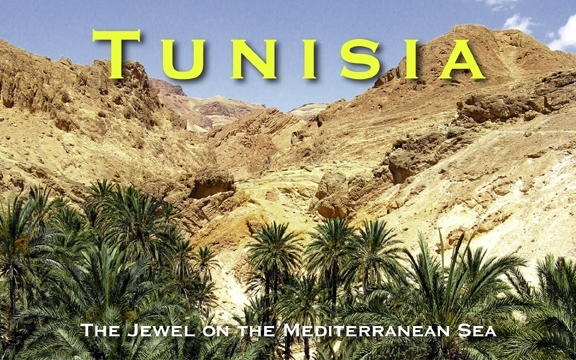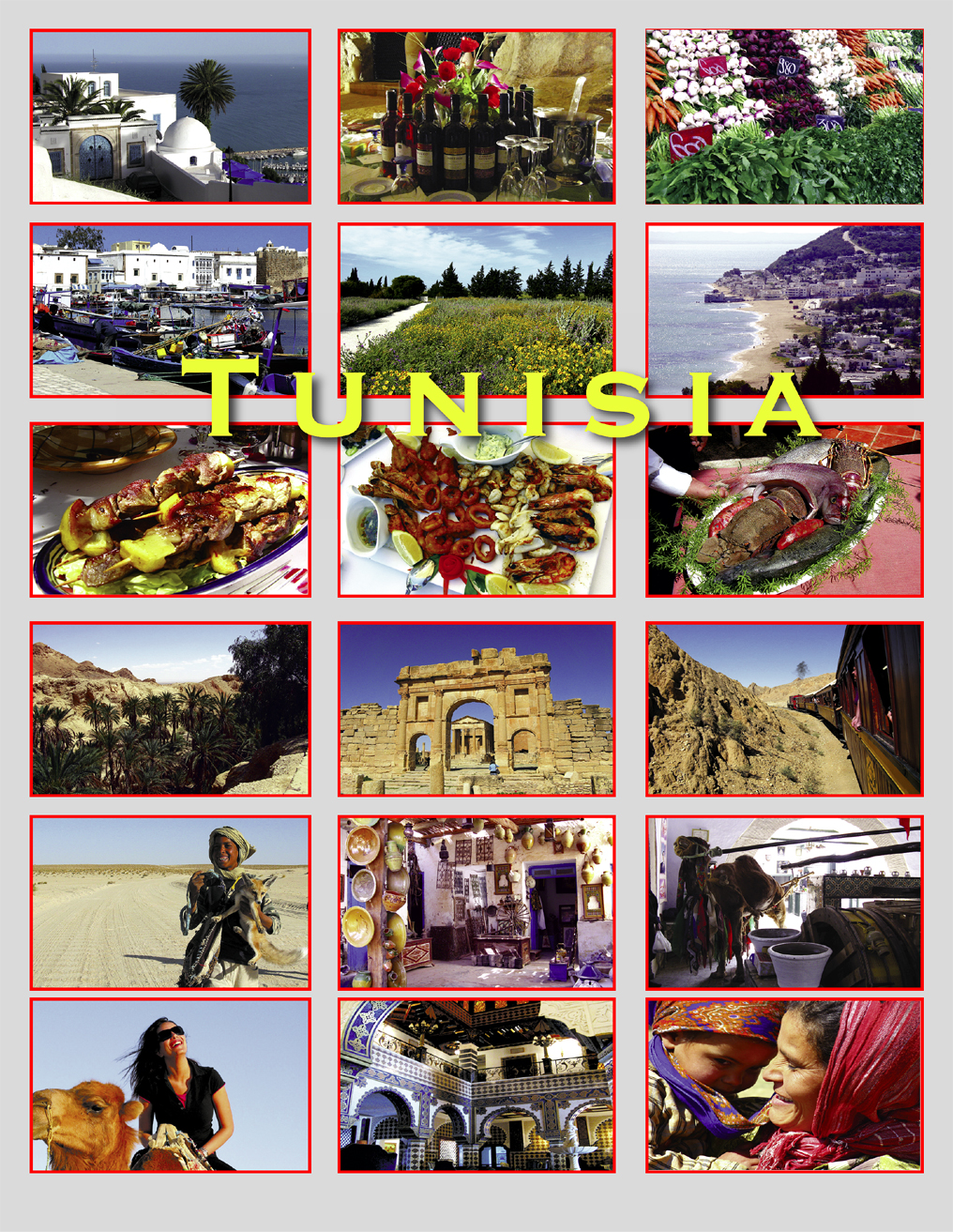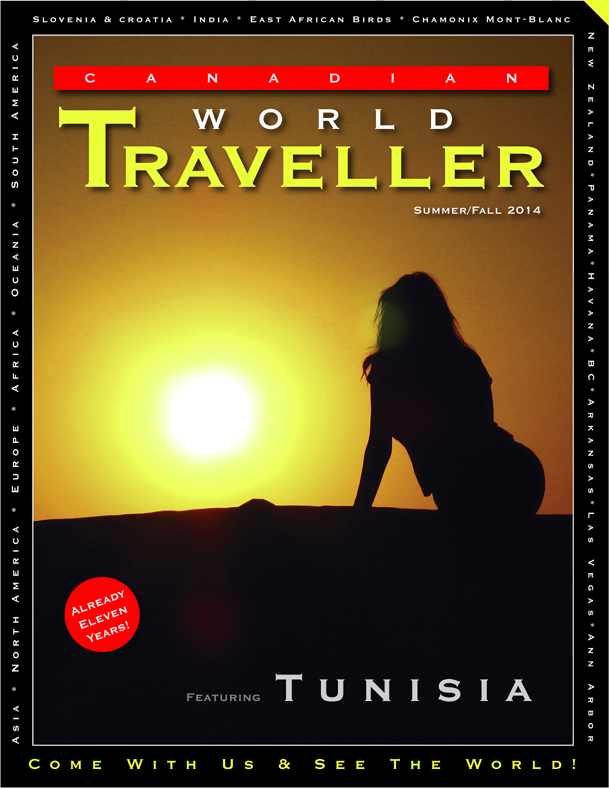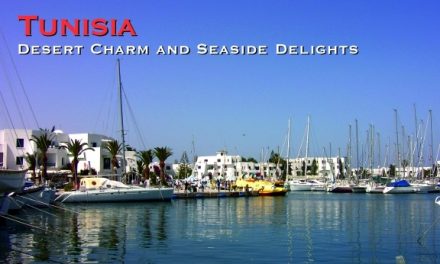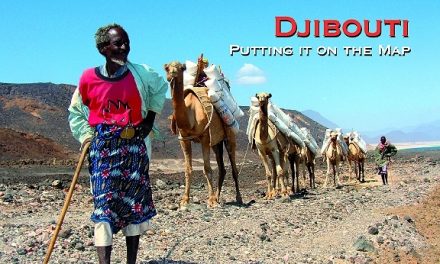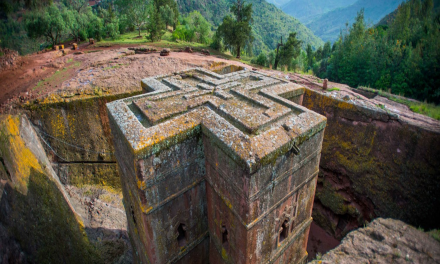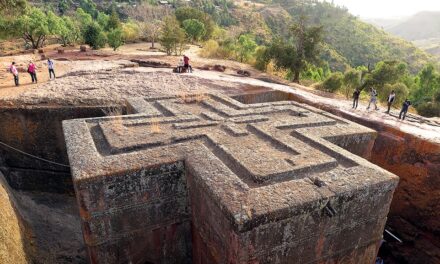Tunisia
The Jewel on the Mediterranean Sea
by Michael Morcos
When thinking of the many beautiful places this world offers as a possible destination for a vacation, Tunisia is sometimes overlooked. This being my first trip there, Tunisia was one great big happy surprise!
Whether it is the breath-taking scenery in the lush green north or the hot and dry deserts in the south, the cuisine, or the unbelievably friendly people, Tunisia tantalizes the senses!
Its history is a wealth of Phoenician, Roman, Islamic and French influence and all this can be experienced with the peace of mind knowing that you are in a safe country.
Our trip began and ended in the north. To the north we would visit the capital Tunis, as well as the coastal towns of Sidi Bou Said, Hammamet and Bizet, followed by a three-day tour of the southern Tunisian oasis towns of Tozeur, Tamerza, Chebika, Mides and Nefta.
Beautiful North Coast
The jagged, mountainous and sunny Mediterranean coastline was a fantastic introduction to Tunisia. I had to remind myself that I was not in Greece as the blue waters and whitewashed houses could easily be mistaken for other parts of this well-travelled sea.
The popular postcard town of Sidi Bou Said was a relaxing way to wash away the jetlag as we wandered through the charming little streets.
Along the way we would watch local women painting Henna tattoos on visitors’ hands and feet. I bought many Tunisian handy crafts such as colourful ceramic plates. Our day would end at a crowded hillside outdoor cafe with mint tea under a golden setting sun.
Tunis
This being our first full day, we would start and end our day in the Tunisian capital. At first glance, Tunis is a clean, organized and quiet city.
There was an obvious North African feel to the city but surprisingly it also had a western flavour. This is probably due to the fact Tunisia was a French colony until 1956. I found on its main boulevard, cafés with outdoor seating that one could mistake for Paris. The western and Arab architecture and street design blended well, giving a unique and pleasant atmosphere.
Marché Central
Our first stop would be the central market. Unlike many food markets I have visited, this one was very clean and well-organized and the vendors were among the friendliest I had ever met.
They took great pride in their produce as they continually cleaned and stacked the counters. Divided in many sections, this large market had almost anything one would want.
Most notable were the sweet smells of the fruit and vegetable section and the marvellously well-presented produce stalls stacked eight feet high by 20 feet across.
Not far away was the seafood section, evidence the sea was not far away. I was amazed by the variety of fish and seafood and watched and photographed the merchants cleaning the day’s catch.
Mornag Wine Cellars
Both the Phoenicians and Romans grew grapes and produced wines in Tunisia. This legacy is still alive and well as we toured the historical underground caves of Mornag where local producers share the cellars as part of a co-op.
A wine tasting of the many splendid reds, whites and even sparkling wine in a dimly lit cave, surrounded by aging oak barrels and a musky smell was truly a great experience.
My favourite wine and choice for the remainder of the trip was the Vieux Magon that rivals the finest wines of France and Italy.
Hammamet
Hammamet lies on the coast and is known for its many great sandy beaches. Dominating the city is the Kasbah (Arabic for fort) where from the upper terrace I got a 360-degree view of the blue ocean, the golden sandy beaches, the Great Mosque, the medina and the white washed houses of the city.
A late afternoon leisurely stroll through the narrow shaded streets and winding alley of the old medina is like a walk back in time. Visiting the many small stores, cafes and souvenir shops found on every corner was a cooling relief from the hot sun and an opportunity to buy Tunisian spices and fragrant essential oils.
By contrast, Hammamet’s new development area has large-scale hotels that tailor to the all-inclusive vacationer. Most of these hotels had large swimming pools and were directly located on or close to the beaches.
Our guide stopped at a couple for short visits. My favourite was the Vincci Lella Baya hotel. I was amazed by the five story high lobby, the detail of its unique interior looking like the set of a Star Wars film.
Roman Tunisia
Tunisia was a prized territory for the Romans as it was and is the closet point to Africa for them. The Romans named this area Africa, derived from the Afri, the name of the tribes who dwelt in the area and thus the name of the whole continent.
The Romans firmly left their mark in Tunisia and a visit to the Utique agrological site and the Sbeitla archaeological site (further south) were evidence of their influence in this part of Africa.
The Utique ruins were still under excavation but what was exposed showed that this was an important Roman site. The mosaic floors that were evident everywhere were mostly intact while some buildings had erect columns and facades.
Most surprising was the green countryside. The Romans chose this place well. Gentle rolling hills, ever green trees and wild flowers dotted the landscape. With the perfect mild spring weather, it reminded me more of Austria than Africa.
Bizerte
Bizerte is the principal town on the northeast cost of Tunisia. First settled by the Phoenicians and used as a strategic port it was later taken by the Romans followed by the Arabs, Turks, Germans and the French. They all seemed to fancy the good life by the sea and after a short visit here I could see why.
The most attractive area of the city is the picturesque old port, where we spent time at the cafes watching the colourful boats come and go and fisherman unloading their catch.
In near perfect sunny weather we took a walk down the tree-lined seaside promenade that runs along the mostly empty beaches. In the gentle ocean breeze I could not help but think of the balance this place. Clean, friendly, warm and beautiful, Bizerte was another of the many great happy surprises on my trip through Tunisia.
Lunch with a View
Perched atop a cliff, La Falaise Restaurant was one of my favourite places to savour the Tunisian seafood.
The vista was breathtaking and the ideal setting to end our tour of the north.
Our waiter brought us a tray full of the day’s catch of fish and crustaceans to choose from. Our selection was shortly prepared and served with Tunisian salad, fresh French breads, couscous, vegetables, spicy olives and of course great wine.
Magnificent South
A short flight out of Tunis brought us to the oasis town of Tozeur. The relatively short one-hour trip was enough to bring us to what seemed like a different country, as we noticed the contrast immediately. This was a much-awaited part of the trip and Tozeur would now be our base for the next three nights. We would explore the many fantastic places and sites that dotted this desert region of Tunisia.
With a population of only 25,000, Tozeur is still one of the major southern towns. Dwarfed by over 200,000 palm trees watered by hundreds of natural underground springs, Tozeur was a paradise. Trees, flowers and water were found everywhere. It was hard to believe beyond the city limits was the desert.
There were plenty of things to see and do. With an overcharged schedule we could only do a bit of the most important things.
The Tozeur medina was small but full of great surprises on every street. Most interesting were the small residential doorways that opened up to large courtyards and dwellings of the local inhabitants.
I loved the cozy cafes that gave me a real sense of being in Northern Africa. Locals would fill these meeting places until the morning hours as they sipped their mint tea and coffee, smoked their water pipes and socialized.
Antique stores were very interesting and had articles dating back decades. I could have spent days looking for those perfect decorative pieces but unfortunately with only small luggage for my trip I was forced to settle for pictures instead.
The Red Lizard
A great time was had on the old fashioned train, the “Red Lizard” as it travelled down rail tracks through desert, water springs, mountain tunnels, deep gorges, steel bridges, blue skies and bright sun.
Tourists from around the globe crowded this little red train. Marvellous was the best way to explain the scenery as I spent most of the train ride near an open window with sweetened mint tea in hand, only briefly stretching my legs during scheduled stops.
Tamerza
Like a mirage the Tamerza oasis stands out in the mostly barren and mountainous desert. Like magic, cool water rushed through underground springs forming a river, waterfalls and small pools, enjoyed by locals and visitors alike.
A walk through the hilly shaded palm tree oasis was a welcome relief to the very hot off-road truck ride.
A refreshing dip would have been even better, but a tight schedule and no bathing suit did not permit this.
The Tamerza Palace hotel that was found on top of a hill had a spectacular view of the surrounding desert mountains. It overlooked the dried out riverbed and deserted Berber town that was abandoned after a great flood destroyed its homes.
This was a perfect place for lunch. The newly built hotel was designed with all the modern amenities and had stylish looking rooms with a Tunisian accent.
Mides
Not far away was the Mides gorge. A North American could easily mistake it for part of the Grand Canyon.
This area that bordered the country of Algeria was made famous by the film ‘The English Patient’. I soon found out the Tunisian south is a popular setting for movie making.
The sheer vertical drop of the gorge was created by many years of erosion by the river below that snaked through it. I was able to get right to the edge of the gorge where I sat and enjoyed the awe-inspiring scenery.
In silence I observed a goat herder and his goats grazing on the few strands of grass on the nearby hill. It was a simple sight made beatific juxtaposed against the big cities, the traffic, the noise pollution and the 9 to 5 routine found back home.
The Real Star Wars
The actual sets of the Star Wars film have been left untouched in the middle of the desert. The many structures that stand against the sandy background were in decay but the government is making plans to freshen up the site and preserve it as it is an often-visited tourist attraction.
A Boy and His Fox
Our driver made a sudden stop. Walking on the side of the dirt road was a young boy waving at us. Proudly he approached us with an animal in his hand. Looking carefully I noticed it was a desert fox. He had caught it himself by setting up traps.
We took pictures of him and his new pet and gave him a small tip. Money in one hand, his pet fox in the other, the boy walked tall and proud with a big smile as bright as the sun.
Camel Ride in the Desert
I could not resist a camel ride through the desert at sunset. It was one of the highlights of my trip. Our 4×4 truck left the roads, paved and unpaved alike, to get to a secluded area known for the fine sand dunes. This was the wild Sahara Desert we all know in photographs and film.
It was a hostile place and a beautiful place at the same time. In both instances, it was humbling. The wide-open spaces were devoid of life. Nothing could possibly grow here. Lack of water and lack of rain meant there were only sand dunes in every direction, as far as the eye could see.
The heat and the sun were unrelenting but our sure-footed camels did not seem to care. Onward we rode until we finally found a spot where we could sit on the edge of a dune and watch the sun set over the horizon leaving a fiery red sky.
In the night we made our way back by the light of the moon and the stars above. It was an experience. It was an adventure. It was a delight!
Kairouan
On the last leg of our journey we would travel overland back to the capitol to catch our flight home. Along the way we would see a drastic change of scenery as we left southern desert and approached more fertile north. We stopped for lunch and toured the holy Muslim city of Kairouan. This city ranks after Mecca and Medina as a major place of pilgrimage.
The very friendly people of this city greeted us with open arms everywhere we went. We visited many different places including a local bakery, a traditional Tunisian pastry shop, the old medina itself and an eighth century well that was still being used. The water in this well was being brought to the surface by using a blindfolded camel that moved in circles driving a mechanism that drew water up. I stood in amazement. Nothing had changed for centuries.
Good-bye (for now)
Time flies when you are having fun and our seven days touring wonderful Tunisia passed all too quickly. My lasting memories of Tunisia will be fond ones. I marvelled at its natural beauty. I was intrigued by its rich and storied history. I adored the great cuisine, fine wines and fresh seafood.
But most of all I will remember the friendly, caring, gentle, and soft-spoken Tunisians who made me feel at home while so far away from mine.
These are reasons enough to return to this hidden gem on the Mediterranean. I can’t wait!

